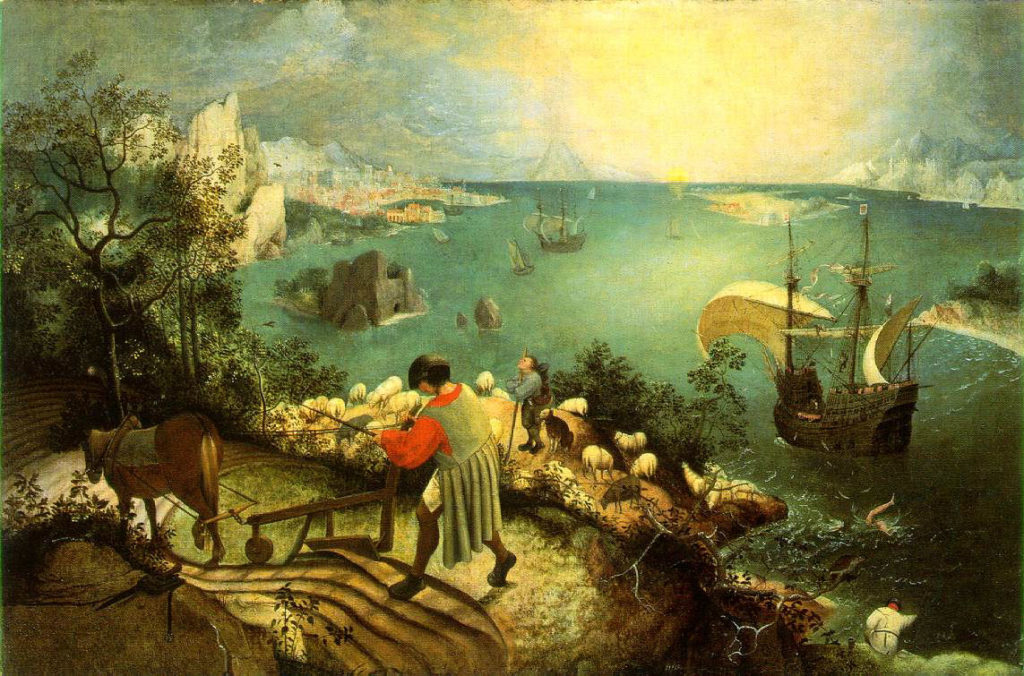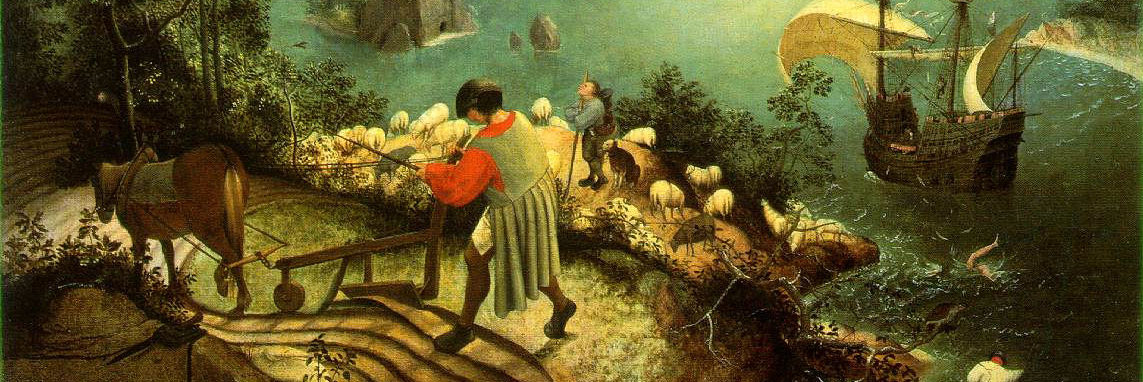One of my favorite paintings is Landscape with Fall of Icarus, by Pieter Breughel. In the foreground is a farmer’s field on a seaside cliff, and a farmer plowing the field behind a horse. In the middle ground, on the right, a big merchant ship is sailing on a beautiful blue-green sea in the direction of a crowded port city. In the background, other tall ships sail across the sea.

If you’ve never seen this painting before, you may wonder why it’s called Landscape with Fall of Icarus. It’s obviously a landscape (or a landscape/seascape). But what does Icarus have to do with hit? If you keep looking, however, you’ll see a little splash near the bottom-right corner of the scene, not far from that big merchant ship. And you’ll see two legs sticking up out of the water.
Then a whole story unfolds…or, perhaps, a commentary on a story you already know. Remember Icarus? His father Daedalus made wings of feathers and wax so the two of them could escape imprisonment. Daedalus warned the boy not to fly too close to the sun. But Icarus was young and brash and convinced that he was invincible, so he flew ever closer to the sun until the wax on his wings melted, and he plummeted into the ocean.
This painting depicts that moment when Icarus has fallen, and he’s about to disappear forever under the waves. But he hasn’t disappeared yet. And nobody in that scene is paying one lick of attention. The sailors go on sailing, and the farmer goes on farming, and the horse—well, he goes on being a horse, thinking his horsey thoughts, entirely oblivious to the fact that this incredible, earth-shattering, literally mythic thing has has just happened. (W.H. Auden famously wrote a poem about this painting, called “Musee des Beaux Arts.“
How are we able to get all that out of one painting? How are we able to make all those connections?
We can make those connections because the painting sits still for us. It’s not going anywhere. Take your time. Keep looking. See what appears. See what comes together for you.
You’ve seen the people in the museum who just stand in front of a painting for fifteen minutes, half an hour, maybe longer? Maybe you’ve been one of those people. A visual artist—a painter or sculptor—creates a beautiful thing. And that thing just sits there. It waits patiently. Hopefully people come to it and look long and hard at it. And the longer they look, the more they see. It’s as if the painter or sculptor has made something that stands outside of time.
But writers don’t have that luxury.
Language can’t stand still. It has to move through time. One word has to make way for the next word, and that word has to make way for the word after that. And your reader is trying to catch each word as it moves past, and hold it long enough to place it in relation to the next words that are coming right behind it.
When you listen to a person speak or read a written sentence, your brain holds each word as it disappears and starts looking for something to connect it to.
Take the first sentence of Don Quixote, for instance.
Somewhere in la Mancha, in a place whose name I do not care to remember, a gentleman lived not long ago, one of those who has a lance and ancient shield on a shelf and keeps a skinny nag and a greyhound for racing.
Your brain sees, “Somewhere in la Mancha,” and it says to itself, adverbial phrase…hold on to that. We’ll know what it means when we get to the verb.
Then your brain sees, “in a place,” and it says to itself, another adverbial phrase…hold on to that one too. The verb is coming.
When you get to that clause “whose name I do not care to remember,” your brain says, ok…that’s an adjective clause. That connects to the noun place right in front of it. It tells which kind of place…but we still don’t know what those adverbials modify…
Then you come to “a gentleman,” and your brain says, Aha! A subject. The verb can’t be far behind… And then, at last, the verb, “lived,” and your brain knows what to do with those adverbials it has been holding in suspension.
It’s astonishing, isn’t it? Your brain is constantly working like that, in real time, holding onto phrases and clauses until it knows where to connect them. It’s a miracle that it happens at all. Loving your reader requires that you help her along with those connections and not make it any harder than it has to be.
You can stare at a painting all day long until its secrets reveal themselves. The painting isn’t going anywhere. But a sentence is always going somewhere. A sentence moves, and your reader has to keep up with it.
A painter hopes a viewer will stand still and stare at his painting and make connections. You don’t want your reader to have to do that. Actually, very few readers will stare. If those connections are too much work, they’ll just move on. And who can blame them?
Clear grammar and sentence structure are all about feeding your readers information in such a way that their brains can make all the necessary connections between sentence parts in more or less the amount of time it takes for their eyes to scan from left to right. If you slow your reader down with sentence structures that require any mental effort to parse, you need do have a good reason. (And, for the record, “I just like the way it sounds” isn’t a good enough reason.)
I know I’ve shared each of the following four rules before—and I may have even shared them all together—but they bear repeating. If you grasp these rules, you will be able to avoid many of the structural flaws that make it hard for readers to connect the parts of your sentences in real time:
- Think where the action is in every sentence, and treat it as your default to express the action as a verb and the actor as the subject of that verb.
- Get to the subject early in your sentence, and get to the main verb soon after that.
- Keep modifiers close to the words they modify.
- When you use a pronoun, be sure its antecedent is clear. It is better to repeat the antecedent than to be vague.
These aren’t the only important guidelines for sentence structure, of course, but they represent a good start on a philosophy of sentence construction.
Your reader can handle tremendous complexity. Human brains are wired for it. Nevertheless, the considerate thing—the thing that will keep your reader reading—is to organize that complexity in such a way that your reader doesn’t even think about the fact that she is processing complex ideas and images.








